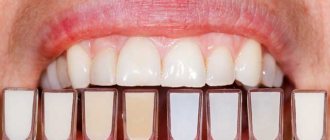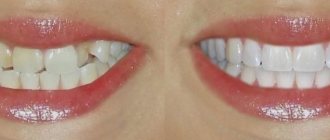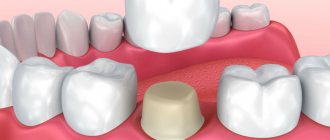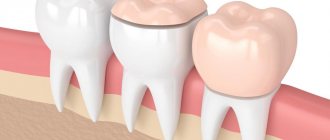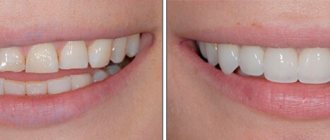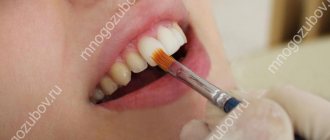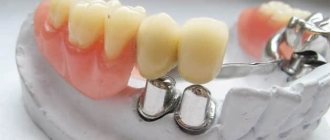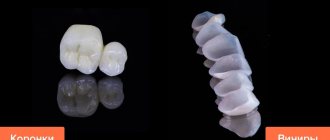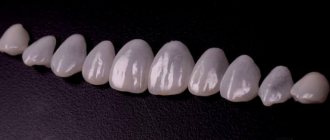- What are veneers
- Indications and contraindications
- Features of the installation process
- Service life of veneers depending on type
A service such as the installation of veneers is becoming increasingly popular in dental clinics. This is a method of dental reconstruction that has a rather aesthetic purpose. As a result of the procedure, the teeth acquire the correct shape and color. This type of dental service is not cheap, so the question of how long veneers last on teeth is quite relevant. There are many features that affect the service life of veneers, it is better to learn about them before the procedure.
What are veneers
Many people believe that veneers are something like implants. In fact, veneers are thin shells - plates that are designed to be installed on the front tooth surface to create the appearance of straight, anatomically colored teeth.
The process of fastening products takes place in several stages. As a result, you can not only restore your teeth, but also eliminate problems with color, shape or position. Plates can be placed on one or more teeth. Such dentures do not require complex installation procedures and look natural, creating the desired “Hollywood smile.”
Modern types of veneers can serve as an alternative to dental products such as braces if there are contraindications to their installation. The advantages of dental onlays include elasticity, strength, durability and reliability. On average, depending on the type of product, the warranty period is from 5 to 15 years.
pros
Fixing veneers is the fastest and most painless way to restore the aesthetics of teeth. Yes, the teeth are pre-treated. However, turning is no more than 0.5 mm.
The minimum duration of the procedure is associated not only with the immediate installation of veneers, but also with the number of visits to the dentist. If the patient does not require pre-treatment, the entire process will require no more than 3 visits to the doctor.
Important: you should not trust advertising that promises a Hollywood smile using veneers in one session. The plates are made in a dental laboratory based on previously taken impressions of the patient’s jaw. The work is complex, requiring extreme concentration and high professionalism. Therefore, it is impossible to create ceramic veneers in an hour or even in 2 hours.
Some methods of prosthetics require a long period of getting used to new teeth. Overlays do not fall into this category. After fixing microprostheses, unusual sensations may occur due to the appearance of a foreign structure in the oral cavity. But in just a day or two, the discomfort will disappear. Ceramic veneers do not affect the patient’s usual lifestyle, eating and diction.
Long service life is one of the main advantages of the plates. On average, veneers “live” for at least 15-20 years. When used correctly, of course. In addition, microprostheses can be installed in patients with high sensitivity - rejection and allergic reactions are excluded.
Indications and contraindications
Despite the fact that dental plates are a safe design that causes complications only in exceptional cases, they are recommended to be used only when indicated. The patient's desire alone is not enough for reconstruction.
Indications for this method of tooth reconstruction:
- damage, chipping or disruption of the natural structure (enamel);
- irregular shape;
- altered or natural “ugly” color;
- gaps or incorrect positioning;
- cracks;
- tetracycline
- hypoplasia or fluorosis;
- wedge-shaped defect.
In a professional clinic, services are not provided without preliminary diagnostics, the purpose of which is to identify the possible presence of contraindications:
- abrasion of dental tissues;
- significant curvature of the tooth;
- bruxism or stomatitis;
- periodontitis, caries or pulpitis;
- periodontitis, gingivitis or periodontal disease.
The doctor may refuse to allow the patient to undergo the procedure if the bite is severely altered, or there is a significant deformation of the position of the teeth, or if there is a large filling. It is also not recommended to place plates on people who do not sufficiently observe hygiene standards. The use of narcotic drugs is considered an absolute contraindication. It is also not advisable for smokers to install plates, since this method of reconstruction will be pointless due to the rapid darkening of the material of the plates.
In what cases are plates installed?
The main purpose of onlays is to eliminate aesthetic defects on the front teeth. It can be:
- Chips and cracks.
- Previously installed fillings that have changed color or cracked.
- Interdental gaps and tooth pigmentation that cannot be eliminated by professional cleaning.
- Pathological abrasion of enamel.
In addition, ceramic veneers help correct minor changes in the bite, crooked teeth, and a decrease in the volume of gum tissue.
Features of the installation process
Before installing veneers, you should consult your dentist. The doctor must tell the patient about all the features of the procedure and how to use dental veneers.
Reconstruction cannot be done in one visit. The duration of recovery depends on the number of teeth.
Stages of installing veneers:
- preliminary examination of the oral cavity;
- selection of the type of linings according to individual characteristics;
- treatment of the tooth surface (removal of top enamel);
- creating an impression for making a plate;
- overlay of temporary veneers (for the period of production of the onlays);
- removal of temporary products;
- installation of manufactured records.
The procedure has a large number of advantages, but there is one disadvantage that often affects patients’ decisions about providing the service - the possible grinding down of the natural crown. This is necessary to align the tooth surface in relation to other teeth. If grinding occurs, the specialist warns the patient in advance.
Disadvantages of the design
The main disadvantage of veneers is the price. For this reason, the procedure is not available to everyone. If we are talking about a minor flaw, then you can choose a more budget option - composite veneers. The material is applied directly to the tooth surface. And under the influence of the light flux, it gradually, layer by layer, hardens, forming a plate.
If the problem is related to darkening of the enamel, you can use a professional whitening procedure. The service is less expensive, but no less effective.
Another disadvantage of plates is the grinding of teeth. No matter what thin ceramic veneers are used, it will not be possible to simply remove the structure from the teeth. You will need to install a new onlay or crown.
Service life of veneers depending on type
Modern clinics offer a wide selection of veneers. Depending on the patient’s wishes and capabilities, the doctor will help you choose the most suitable option for overlays. Regardless of cost and material, products are always made individually.
The type of material from which the overlays are made affects the aesthetic result, as well as the service life. Expensive products have higher performance indicators.
There are three types of veneers: composite, ceramic and zirconium. There is another type of overlay, which is also called “Hollywood” - Lumineers.
Composite
Plates made of composite, which is a high-quality filling material, but at a cost, this is the most affordable option. In addition, dental patients are often attracted by the advantage of composite veneers - quick installation. But applying the material directly to the teeth in a thin layer is only suitable for minor adjustments. However, there is a drawback - the composite is stained to match the natural color of the patient’s teeth. If an impression is made, it will take more time, but this option is of better quality.
Since this is a budget option, you should understand that composite veneers have a service life and maintenance that are two interrelated concepts. When reconstructing using this method, you should carefully follow the recommendations of a specialist. On average, composite overlays will last 8 years.
Ceramic
The option of ceramic products is characterized as more durable and reliable. Their advantage is that the plates are not affected by dyes or food deposits. They continue to remain white throughout their entire service life. The manufacturing process is standard - based on an individual cast. Such plates have another significant advantage - they do not require the procedure of cutting down the enamel. How to care for ceramic veneers, you need to consult a doctor. Their service life can be up to 17 years.
Zirconium
Veneers made from zirconium dioxide are considered to be the most durable. The sketch for plates of this type is made using computer programs that create an individual model of the lining. Based on this sketch, the veneer is produced on a special automatic machine. To improve the quality of the product, an additional layer of porcelain material is applied to its surface. The overlays are characterized by a thin and transparent structure.
Zirconium veneers are distinguished by the following advantages: natural color, which does not change under any external influence, including smoking, the thinnest possible layer and biocompatibility.
The service life of zirconium dioxide veneers is the longest among all options - up to 20 years. However, these models of linings cost from 7,000 rubles per unit. The high price is justified by the method of manufacturing the product, the use of high-quality material and its service life.
Lumineers
The most expensive option is lumineers, which are used to create the “Hollywood smile” effect. Despite the fact that inexpensive material (ceramics) is used to create the plates, the service life of such veneers is the same as that of zirconium veneers - 20 years.
Lumineers differ from ceramic onlays in thickness; the “Hollywood” version is twice as thin and does not require tooth grinding. However, unlike zirconium dioxide products, they have a significant drawback - the natural color of the enamel shines through them; if it is dark, then the aesthetic appearance will no longer have the desired effect.
As a result, we can conclude that the service life of veneers depends mainly on the material from which they are made and the method of their creation. But product care and compliance with recommendations, which is based on the characteristic features of the material (for example, dye sensitivity, thin layer, etc.), can also have an impact on reducing the operating time. The condition of the teeth themselves also plays a certain role. If there are dental problems, you should get rid of them before reconstruction, and then visit a specialist at least twice a year for preventive purposes.
Clinic “A - Medic” is a dental center that has been providing implantology services for several years. We offer installation of high-quality veneers (ceramic, composite, lumineers, etc.) with a service life guarantee.
The clinic often holds promotions and discounts that allow you to get the “smile of your dreams” at an affordable price. On the website you can see prices for services, see photos of our patients before and after the procedure, and also read reviews about the work of specialists and the results of services provided in the clinic.
Production technology
Ceramic veneers are usually made using three techniques:
- Applying the composition to a plaster model followed by heat treatment. The dental technician evenly distributes the composition over the surface of a special material that holds the paste during firing. The technique is inexpensive and allows reducing shrinkage of the structure.
- Casting. In this case, a model of future ceramic veneers is first created using wax. Then it is fixed in a refractory mass and installed in the sprue. Processing is carried out under high temperature. At the final stage, the dental technician paints the plates in a color that matches the patient’s tooth enamel.
- Pressing (Emax). More modern technology that reduces the porosity of the material. This ensures maximum structural strength. As a result, pressed plates have a longer service life. After processing, ceramic veneers are coated with a special compound that adds shine to the overlays.
Recently, the digital method of making veneers using a milling cutter has become popular. The model for the plates is obtained using a non-contact scan of the patient's oral cavity. A computer program calculates the structure. The sample is then sent for milling. The advantages of the method are obvious: the automated process eliminates possible inaccuracies and errors in the production of microprostheses.
Budget analogue
There is an easier and faster way to restore teeth. Composite veneers help with this - a polymer in the form of a paste that is applied directly to the surface of the tooth. The composition is mixed in the dentist's office, which allows you to complete the procedure in one visit. Of course, if there is no need for preliminary treatment of teeth and soft tissues.
The composite has good aesthetics and does not require significant grinding of natural teeth. Hardening is carried out layer by layer, under the influence of light flux. This provides the necessary strength to microprostheses. The technique is suitable for restoring lateral teeth.
Disadvantages of polymer restoration:
- Shorter service life compared to ceramic veneers - no more than 5-6 years.
- Instability to pigmentation. The material changes color over time and absorbs coloring components.
- Imperfect match to the shade of natural enamel.
Care instructions
After dental restoration, you want microprostheses to last as long as possible. This is a completely doable task if you follow the recommendations for caring for ceramic veneers. There are no complicated regulations. The rules are the same as for preserving natural enamel:
- Daily oral hygiene. Use a medium-hard toothbrush and a toothpaste without abrasive particles (not whitening).
- To clean the interdental spaces, it is recommended to use dental floss and rinse your mouth after eating.
- Do not eat too hard foods. Avoid sudden changes in temperature (very hot and cold food).
It is also important to visit the dentist 1-2 times a year for a preventive examination and professional oral hygiene.
In the first days after installation of veneers, unusual sensations may occur due to the appearance of foreign material in the mouth. Especially if the teeth have changed length after prosthetics. But the discomfort will disappear after 1-2 days.
Diagnostics
The fixation of ceramic plates is carried out in three stages: preparation for the installation of veneers, production of the structure and fixation on the teeth.
Correctly performed diagnostics determines how long the orthopedic structure will serve the patient. In addition to the condition of the teeth, it is important to identify possible hidden pathologies in the bone and soft tissues of the jaw. And also carefully study the anatomical structure of the teeth being restored.
At EspaDent clinics, specialists conduct radiographic examinations for more accurate diagnosis. In complex cases, a modern 3D tomograph is used, which creates three-dimensional, layer-by-layer images of both jaws. During a consultation in our clinics, the doctor will offer the best options for microprostheses and immediately indicate the cost of the procedure.
Pak Roman Vladimirovich
Specialization: orthopedic dentist Work experience: more than 25 years Place of work: Dentistry ROOTT m. Butyrskaya/dd> Specialist in the field of dental prosthetics:
- microprosthetics – veneers, inlays (ceramic, based on precious metals), stump inlays;
- fixed prosthetics with solid cast, metal-ceramic, all-ceramic, metal-ceramic based on drags. metal structures;
- prosthetics on implants;
- removable prosthetics – production of complete, partial, nylon, clasp removable dentures with various types of locking fasteners and a telescopic fixation system.
Manufacturers
To protect yourself from low-quality prosthetics, check with the clinic about what materials are used in the procedure. Mainly large companies specialize in the production of ceramic veneers. There aren't many of them.
The most famous company Nobel Biocare is a leader in implantology and prosthetics. It was this manufacturer that developed the popular protocols for implantation procedures All-on-4, All-on-6, Trefoil, etc. In the case of installing veneers, the company specializes in the production of zirconium plates.
The list includes German and Japanese companies that produce their products under the brands Katana, Prettau and BruxZir Anterior. The leader in the production of pressed and solid ceramics is Ivoclar Vivadent, which specializes in Emax technology.
Many years of experience, modern materials and strict quality control allow these companies to occupy a strong position in the dental materials market.
Price issue
The cost of ceramic veneers is influenced by the material, installation method, and complexity of the procedure. As well as the qualifications of the doctor and the reputation of the clinic. On average, prices for pressed ceramics start at 23 thousand rubles. Zirconium ones will cost 35 thousand and more, composite ones - from 10 thousand rubles.
If after diagnosis the patient needs dental treatment, the final cost will be higher.
At EspaDent clinics, the patient learns the final amount immediately after the initial diagnosis. No surcharges or hidden fees. For expensive procedures, our patients have the option of interest-free installments. Diagnostics and initial examination in all EspaDent clinics are free of charge.
